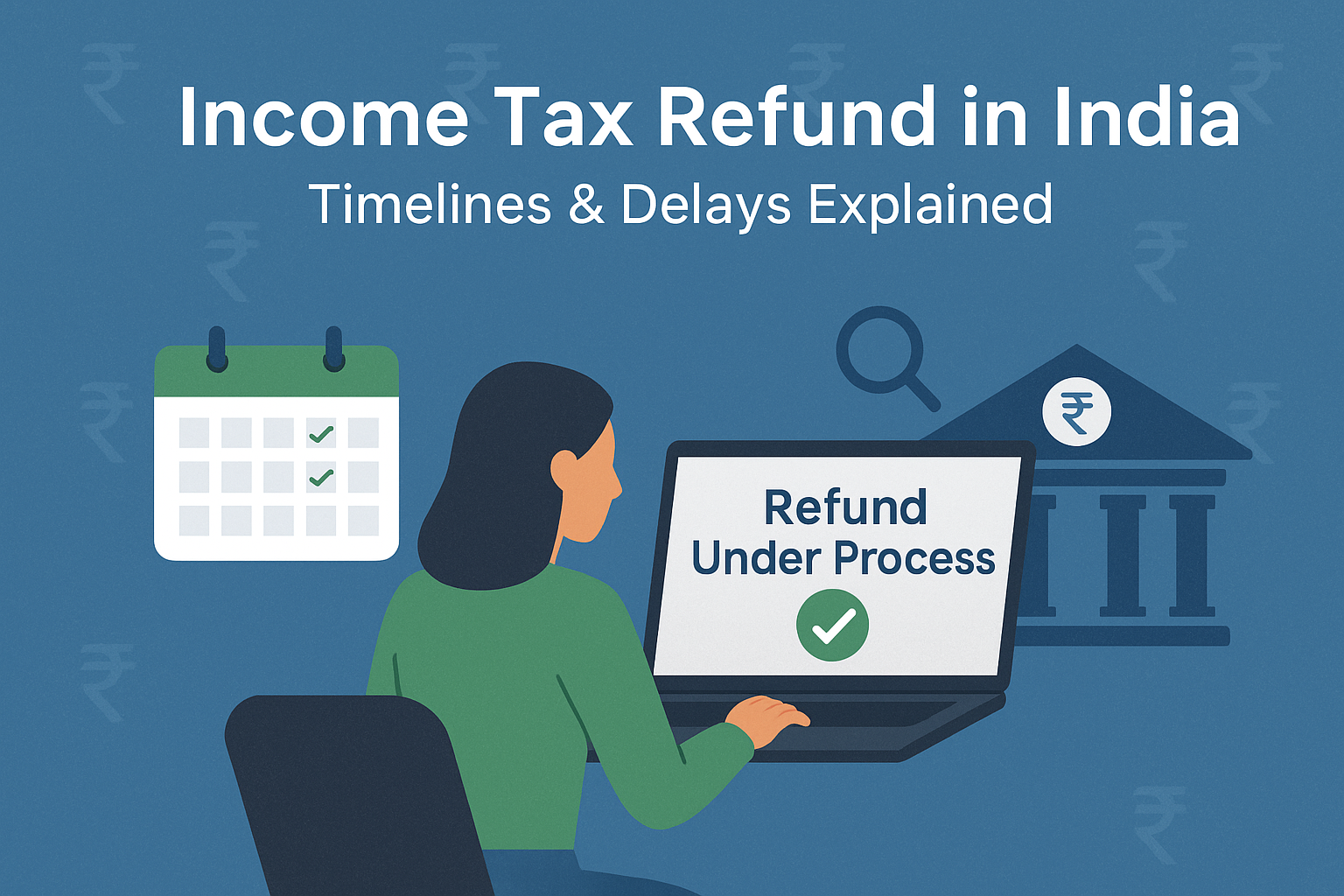Many taxpayers this year have been left waiting for their income tax refunds, even after filing their returns on time. The delays can stretch from a few weeks to several months, often caused by small but critical issues such as unverified returns, incorrect bank details, or mismatched information between the ITR and Form 26AS.
According to Rajeev Mehra, FCA, a Delhi-based chartered accountant, most refund delays have straightforward explanations. “A refund doesn’t usually get stuck without reason,” he says. “In most cases, the Income Tax Department is simply waiting for a correction or confirmation from the taxpayer’s side.”
This article explains the key reasons behind refund delays, outlines the exact steps you can take to fix them, and shares practical ways to track your refund status through the Income Tax portal.
How Long Does It Usually Take to Get an Income Tax Refund?
In most cases, once an income tax return is verified and processed, refunds are credited within 7 to 45 days. The exact timeline depends on factors such as whether the return was filed online or offline, the accuracy of the details submitted, and whether the return has been flagged for additional review by the department.
According to Rachit Chawla, tax advisor and founder of Finway Capital, delays beyond a month should not be ignored. “If more than 30–45 days have passed after verification, taxpayers should actively check their refund status on the Income Tax portal rather than simply waiting for the money to arrive,” he explains.
Common Reasons Your Tax Refund May Be Delayed
Delays in income tax refunds are not unusual, and in most cases, they can be traced to a handful of common issues. Understanding these reasons — and knowing how to address them — can save you weeks of uncertainty.
1. Errors in Bank Details
Even a minor mistake, such as an incorrect IFSC code or a single wrong digit in the account number, can prevent the refund from being credited. Many taxpayers assume their bank details are accurate, but overlook the requirement of pre-validation on the portal.
What to do:
Log into the Income Tax e-Filing portal → Go to Profile → My Bank Accounts. Ensure your bank account is pre-validated and linked with your PAN. Without this step, refunds cannot be processed, even if the rest of your return is accurate.
2. ITR Not Verified
Filing your return is only the first step. Refund processing will not begin unless you verify your Income Tax Return (ITR). Many taxpayers miss this step, assuming that submission alone is enough.
What to do:
Verify your ITR within 30 days of filing. You can do this instantly using Aadhaar OTP, net banking, or by physically sending a signed ITR-V form to CPC Bangalore. Delaying verification will automatically delay refunds.
3. Outstanding Tax Dues or Mismatched Records
Refunds are often withheld if the department detects discrepancies — such as pending tax dues, mismatches between TDS claimed and reported in Form 26AS, or differences between your Annual Information Statement (AIS) and ITR entries.
Expert insight:
“Taxpayers should carefully reconcile their ITR data with Form 26AS and AIS before filing. Even small mismatches, such as differences in reported interest income, can delay refunds,” explains Amit Gupta, Partner at ASC Consulting.
What to do:
Download your latest Form 26AS and AIS from the e-filing portal and compare them with your ITR. If you find errors, file a rectification request or consult a tax professional to avoid unnecessary delays.
4. Random Scrutiny or Additional Checks
Sometimes, even if everything in your return is accurate, the IT department may flag your filing for random scrutiny. This is part of their compliance and quality control checks and does not always indicate a mistake.
Expert note:
“Random scrutiny is not a reflection of wrongdoing. It is simply the department’s way of ensuring that all filings meet compliance standards,” says Priya Mehra, Chartered Accountant at Taxwise India.
What to do:
If you receive a notice, respond promptly through the e-filing portal. Keep all supporting documents (bank statements, investment proofs, salary slips, etc.) ready in case further clarification is sought. Ignoring notices will indefinitely stall your refund.
5. High Volume Processing During Peak Season
During the busy filing period (July–September), the department faces a surge in returns, which can lead to longer-than-usual processing times. Even if your return is perfect, delays are possible simply due to workload.
What to do:
Keep checking your refund status periodically on the portal or through the TIN NSDL website. As long as your bank details and verification are complete, the refund will be processed — it may just take longer than usual.
Pro Tip: Always keep a screenshot or PDF copy of your ITR acknowledgement, Form 26AS, and AIS for quick reference. These documents are often the first line of defense in case of delays or disputes.
How to Check the Status of Your Income Tax Refund
If you are waiting for your income tax refund, there are two primary ways to check the status:
- Through the NSDL Refund Tracking Portal – Visit the NSDL (now Protean) refund tracking page, enter your PAN and the relevant assessment year, and the system will show your latest refund status.
- Through the Income Tax e-Filing Portal – Log in using your PAN, navigate to Services → Refunds → View Refund Status, and check the latest update.
The status messages you may come across include:
- Refund credited – The refund has been successfully deposited in your bank account.
- Refund failed (bank error) – The credit attempt did not go through, usually due to incorrect or unvalidated bank details.
- Refund under process – Your return is being reviewed and processed; the refund will be released once checks are complete.
- Refund adjusted against outstanding demand – If you have past tax dues, the refund may be adjusted against them, with details shown on the portal.
What to Do if Your Refund Is Delayed
If the refund is taking longer than expected, here’s a practical checklist to follow:
- Verify bank details – Log in to the e-filing portal → Profile → My Bank Accounts. Ensure your account is pre-validated and linked with your PAN.
- Track refund status regularly – Use either the IT portal or NSDL site to stay updated.
- Check for IT notices – Look for any communication in your portal inbox or email; respond promptly if clarification is requested.
- Cross-check tax statements – Review Form 26AS and AIS (Annual Information Statement) to ensure TDS, advance tax, and income entries match your filed return.
- Raise a grievance – If no issues are visible but the refund is still stuck, submit a grievance request through the e-filing portal.
- Helpline support – If all else fails, contact the Central Processing Centre (CPC) Bengaluru at 1800-103-4455 (toll-free) for assistance.
Don’t Overlook the Small Details
“Even minor lapses — like forgetting to e-verify your ITR or missing an update to your bank details — can stall refunds for weeks or even months,” explains Anil Sharma, Partner at Sharma & Associates, Chartered Accountants. “Careful checks at the time of filing go a long way in avoiding unnecessary delays.”
Staying Ahead of Refund Delays
Most refund issues come down to simple oversights or missing steps. Keeping your details updated, verifying returns promptly, and tracking notices from the IT department usually resolves them before they become long delays. If your refund remains pending beyond three months despite everything being in order, it’s best to raise a grievance through the portal or take guidance from a tax professional who can push the process forward.
Frequently Asked Questions on Income Tax Refunds
How long does it usually take to receive an income tax refund in India?
Refunds are generally credited within 7 to 45 days once the return is processed and verified. Complex cases, mismatches in income details, or additional checks by the IT department can extend this timeline.
Why is my ITR refund delayed even after 45 days?
Delays often happen due to unverified returns, incorrect bank details, mismatches in TDS reported vs. Form 26AS/AIS, or pending IT notices. Sometimes the IT department may also adjust refunds against outstanding demands from earlier years.
How can I check my income tax refund status?
You can track refund status in two ways:
- NSDL Refund Tracking portal – enter your PAN and assessment year.
- Income Tax e-filing portal – log in, go to the “View Refund Status” option.
The status will show whether the refund is credited, under process, failed due to bank issues, or adjusted against past dues.
What should I do if my refund is shown as “failed”?
A “refund failed” status usually points to bank account errors such as an inactive account or mismatched details. Log in to your IT portal, go to Profile → My Bank Account → Pre-validate, and update the correct details.
Can small mistakes really delay my refund?
Yes. Missing steps like not e-verifying your ITR, entering the wrong IFSC code, or overlooking pre-validation of your account can hold up refunds for months. Correcting these issues early helps avoid unnecessary delays.
What action should I take if my refund is pending for more than three months?
If everything seems correct but the refund is still pending, you can:
- Raise a grievance on the IT e-filing portal.
- Contact the CPC Bengaluru helpline (1800-103-4455).
- Consult a tax professional if the delay continues despite following up.

